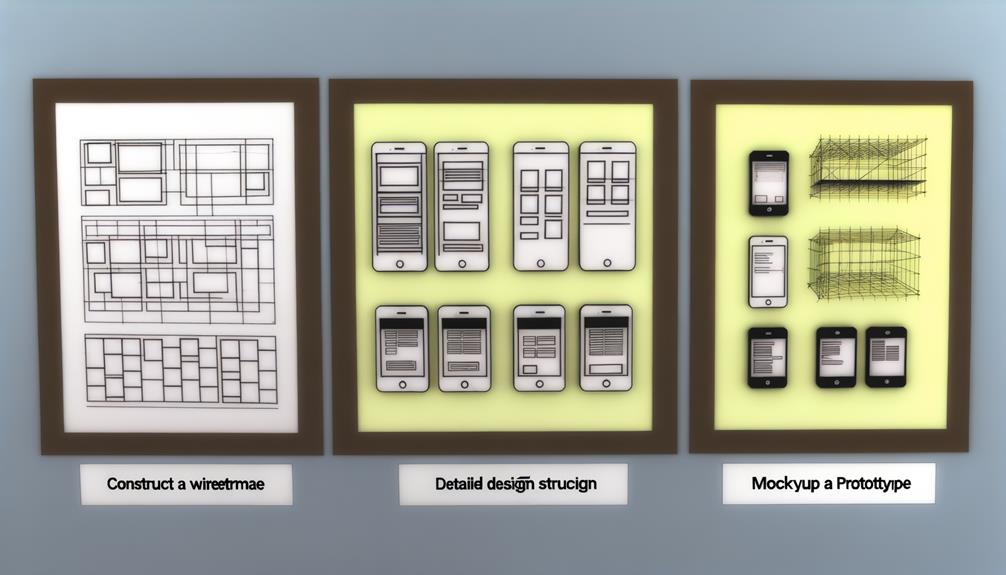As we embark on the journey of website wireframing, we often wonder if the processes and tools we employ truly align with industry best practices and standards.
It's essential to understand that the foundation of any successful web design project lies in the meticulous planning and execution of wireframes. These wireframes serve as the blueprint for the entire website, guiding its development and functionality.
But what are the key elements that make up an effective wireframe, and how do we navigate the complex landscape of wireframing tools and examples?
Join us as we unravel the intricacies of website wireframing, exploring the processes, tools, and real-world examples that will equip us to elevate our design projects to new heights.
Understanding Website Wireframes

Understanding website wireframes is essential for creating a successful and user-friendly website design. As we delve into this topic, we gain the power to visualize the layout and structure of a website, empowering us to craft an intuitive user experience.
By comprehending the purpose and benefits of wireframes, we liberate ourselves from ambiguity and pave the way for clear, effective communication and collaboration.
This knowledge is pivotal for project success, as it allows us to align our vision with stakeholders and team members. With a confident understanding of website wireframes, we can envision the user flow, simplify the design, and guide users seamlessly through conversion points.
Our mastery of wireframing techniques empowers us to create websites that not only meet goals but exceed them, liberating users with an unparalleled digital experience.
Creating a Simple Wireframe
Let's start by outlining the key steps to create a simple wireframe for your website design. First, identify the goal of your website and understand the user flow and entry points. Then, determine the appropriate wireframe size and design it using physical or digital tools. Guide the user through conversion points and simplify and refine the wireframe. Seek feedback from stakeholders to ensure alignment with the website's objectives. To add depth to the discussion, here's a comparison table of wireframes, mockups, and prototypes:
| Wireframes | Mockups | Prototypes |
|---|---|---|
| Low-fidelity, basic layout | Mid to high-fidelity, visual representation | Functional, interactive model |
| Focus on structure and functionality | Emphasis on visual design and user interface | Includes interactive elements and user interactions |
| Used for early-stage planning | Used for design approval | Used for testing and validation |
Tips for Effective Wireframing

To ensure successful wireframing, it's essential to start with low-fidelity wireframes and gradually progress to high-fidelity wireframes.
Using pixel measurements for accurate sizing and aligning the design with website goals is crucial.
This approach allows for rapid ideation and iteration, fostering creativity and innovation.
It's crucial to iterate and gather feedback throughout the process.
Incorporating insights helps refine the wireframes and ensure they effectively meet user needs.
Embracing this iterative mindset liberates the design process.
It empowers us to explore diverse possibilities and push the boundaries of conventional thinking.
By embracing flexibility and adaptability, wireframing becomes a tool for liberation.
It enables us to break free from constraints and unleash the full potential of our website designs.
Exploring Wireframe Types
Exploring different types of wireframes provides valuable insight into the diverse approaches and techniques used in website design.
Sketch wireframes offer a quick and low-fidelity way to visualize ideas, perfect for early brainstorming.
Gray box wireframes provide a more detailed view, focusing on layout and structure without distracting details.
Interactive wireframes add functionality, allowing for user interaction and testing.
Annotated wireframes include additional notes and explanations to provide context for the design.
Responsive wireframes adapt to different screen sizes, ensuring a consistent user experience across devices.
Understanding these wireframe types empowers designers to choose the most suitable approach for their specific project, ultimately leading to more efficient and effective website design.
Wireframes, Mockups, and Prototypes Compared

How do wireframes, mockups, and prototypes differ in their contributions to the website development process, and how do they collectively enhance the efficiency and effectiveness of design projects? Each of these elements plays a crucial role in different stages of website development, offering unique benefits and functionalities. Here's a comparison of wireframes, mockups, and prototypes:
| Wireframes | Mockups |
|---|---|
| Low-fidelity | Medium to high-fidelity |
| Focus on structure and functionality | Detailed visual and design elements |
| Used for layout and content placement | Showcase visual design and branding |
| Cost-effective for early-stage feedback | Ideal for user testing and feedback |
| Quick to create and iterate | Time-consuming to create and refine |
| Prototypes | |
| High-fidelity | |
| Interactive and functional | |
| Used for user testing and validation | |
| Close to the final product | |
| Allows for user interaction testing | |
Each component serves a distinct purpose, contributing to the overall success of the design process.
Importance of Wireframing in Project Success
Wireframing is a critical step in our project's success, providing the foundation for clear communication and effective collaboration among all stakeholders. It's essential for several reasons:
- Alignment: Wireframes ensure that everyone involved in the project is aligned with the same vision and goals.
- Efficiency: By visualizing the layout and structure early on, we can save time and resources in the later stages of the project.
- Feedback: They serve as a tangible reference point for gathering feedback and making necessary adjustments.
- Clarity: Wireframes help in clarifying the user experience and functionality, ensuring that the final product meets user needs effectively.
Collaborative Aspects of Wireframing

In our collaborative wireframing process, we prioritize open communication and collective ideation to ensure a cohesive and well-defined vision for our project. By fostering a collaborative environment, we empower every team member to contribute their unique perspectives, leading to innovative and inclusive wireframe designs. Our approach encourages transparency, feedback, and iteration, allowing us to harness the collective intelligence of our team and stakeholders. This collaborative effort not only enhances the quality of our wireframes but also promotes a sense of ownership and commitment to the project's success. Through our shared vision and unified purpose, we liberate creativity and drive towards creating impactful and user-centric wireframes.
| Benefits of Collaborative Wireframing | Emotional Impact |
|---|---|
| Fosters inclusivity and diversity | Empowerment |
| Encourages innovation and creativity | Inspiration |
| Strengthens team unity and commitment | Motivation |
| Enhances project success | Fulfillment |
Frequently Asked Questions
What Are Some Common Mistakes to Avoid When Creating a Website Wireframe?
When creating a website wireframe, we avoid common mistakes like overcomplicating the design, neglecting user feedback, and skipping the low-fidelity stage.
By keeping the design simple, gathering continuous feedback, and starting with low-fidelity wireframes, we ensure a user-centric approach and efficient iteration process.
This approach aligns with our goal of creating effective wireframes that support the website's objectives and user needs.
How Can Website Wireframes Help With User Testing and Feedback?
Website wireframes can enhance user testing and feedback by providing a visual representation of the website's structure and layout. They help in simulating user interactions, identifying potential usability issues, and gathering valuable feedback early in the design process.
This allows for iterative improvements and ensures that the final website design meets user needs and expectations. Additionally, wireframes facilitate effective communication and collaboration among project stakeholders, leading to a more user-centric and successful website.
Are There Any Specific Tools or Software Recommended for Creating Website Wireframes?
We recommend using tools like Adobe XD, Sketch, or Figma for creating website wireframes. These tools offer a range of features for designing wireframes, from simple layouts to interactive prototypes.
Their collaborative capabilities and user-friendly interfaces make them ideal for efficient wireframing. Additionally, they allow for seamless integration with other design and development tools, streamlining the entire website creation process.
How Can Wireframes Be Used to Communicate Design Ideas With Non-Design Team Members?
We can use wireframes to communicate design ideas with non-design team members by providing a visual representation of the website's structure and layout.
This allows for easier understanding of the design concept and functionality, facilitating constructive feedback and collaboration.
What Are Some Best Practices for Incorporating Responsive Design Into Wireframes?
Incorporating responsive design into wireframes involves considering various screen sizes and device orientations. We prioritize fluid layouts and flexible elements to ensure seamless user experience across all devices.
Consistency in content hierarchy, navigation, and interactions is crucial. By implementing best practices like mobile-first approach, we guarantee that our wireframes adapt effectively to different devices.
This approach aligns with the evolving digital landscape and empowers users with a seamless browsing experience.
Conclusion
In conclusion, website wireframing is an essential step in the web design process, laying the foundation for successful projects.
By understanding the purpose, benefits, and various types of wireframes, we can create effective designs that meet the website's goals.
With the right tools and collaborative approach, wireframing empowers us to iterate and refine our designs, ultimately leading to a seamless and user-friendly website.
Embracing wireframing as a crucial aspect of our workflow will undoubtedly elevate our design projects.







